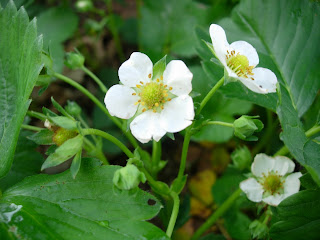 “Humans, like bees, are drawn instinctively to flowers. It’s obvious what good it does bees to be born liking flowers, but what conceivable benefit could such a predilection offer people?”
“Humans, like bees, are drawn instinctively to flowers. It’s obvious what good it does bees to be born liking flowers, but what conceivable benefit could such a predilection offer people?”  The economic explanation is that people can’t afford to pay attention to flowers until they have enough to eat; a well-developed culture of flowers is a luxury that most African historically has not been able to support. The other explanation is that the ecology of Arica doesn’t offer a lot of flowers, or at least not a lot of the showy ones. Relatively few of the world’s domesticated flowers have come from Africa… what flowers one does encounter on the savanna, for example, tend to bloom briefly and then vanish for the duration of the dry season. However, as Goody points out, Africans quickly adopted a culture of flowers wherever others introduced it.
The economic explanation is that people can’t afford to pay attention to flowers until they have enough to eat; a well-developed culture of flowers is a luxury that most African historically has not been able to support. The other explanation is that the ecology of Arica doesn’t offer a lot of flowers, or at least not a lot of the showy ones. Relatively few of the world’s domesticated flowers have come from Africa… what flowers one does encounter on the savanna, for example, tend to bloom briefly and then vanish for the duration of the dry season. However, as Goody points out, Africans quickly adopted a culture of flowers wherever others introduced it. To judge from my own experience, boys of a certain age couldn’t care less about flowers. For me, fruits and vegetables were the only things to grow, even those vegetables you couldn’t pay me to eat. I approached gardening as a form of alchemy, transforming seeds and soil and water and sunlight into things of value…

 ones that had a point, that foretold the fruit to come: the pretty white-and-yellow button of a strawberry blossom (right photo) that soon would swell and redden, the ungainly yellow trumpet that heralded the zucchini’s coming.
ones that had a point, that foretold the fruit to come: the pretty white-and-yellow button of a strawberry blossom (right photo) that soon would swell and redden, the ungainly yellow trumpet that heralded the zucchini’s coming.The other kind, flowers for flowers’ sake, seemed to me the flimsiest of things, barely a step up from leaves, which I also deemed of little value; neither achieved the sheer existential heft of a tomato or cucumber. Where do I have the time for anything so frivolous as a flower?
 The only time I liked tulips was right before they opened, when the flower still formed a closed capsule that resembled some sort of marvelous, weighted fruit. But the day the petals flexed, the mystery drained out of them, leaving behind what to me seemed a weak, papery insubstantiality.
The only time I liked tulips was right before they opened, when the flower still formed a closed capsule that resembled some sort of marvelous, weighted fruit. But the day the petals flexed, the mystery drained out of them, leaving behind what to me seemed a weak, papery insubstantiality.But then, I was ten. What did I know about beauty?



No comments:
Post a Comment